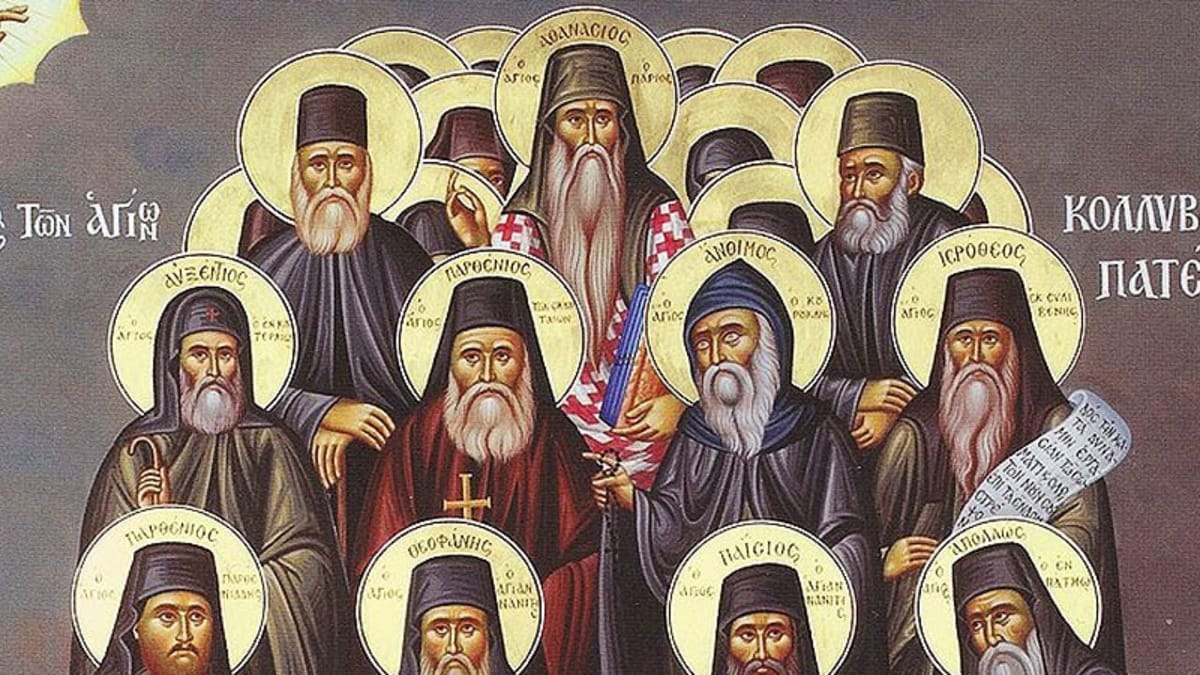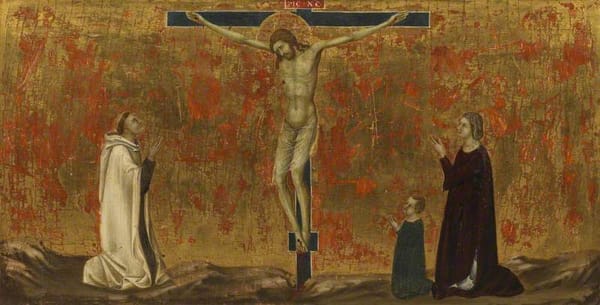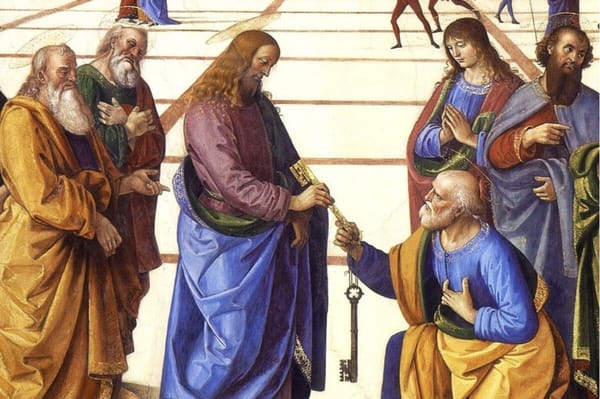The Heart's Reasons: Philokalic Revival from Athos to the Anglosphere
From a fall into neglect even among the monks of Mt. Athos, the texts of the Philokalia have enjoyed a remarkable success in the modern era.

Perhaps the most visible and recognizable manifestation of the Eastern Orthodox Church in the spiritual agora is the Jesus prayer, also known as the prayer of the heart. "Lord Jesus Christ, Son of God, have mercy on me [a sinner]."
While the antecedents of this prayer extend far back into the practice of the Desert Fathers in Egypt and have clear scriptural inspiration, the particular use of this phrase and its correlation with imageless contemplative prayer become discernible in the medieval texts associated with the hesychast spirituality of Mt. Athos. That those texts and the living practices they reflect, elements of which continue to be passed on through oral tradition, have come down to us in the modern era and become part of the lives of householding laity as much as clergy or monks is a legacy of their modern revival through the Philokalic movement that emanated from specific centres in Greece and Russia to reinvigorate the spiritual life of the Byzantine East as a whole in whatever measure it could be received by the constituent churches.
In the social sphere, the prayer of the heart may be regarded as the most vital wellspring of soft power for the Eastern Church as it managed to survive the collapse of the Byzantine Empire and the mainly Slavic confessional states with their distinctive inculturated forms of Orthodoxy amid the ongoing turbulence of a secular age. In the personal lives of many Christians throughout the world, this simple prayer has blossomed as an expression of the indwelling of the Son of God in their hearts and the generosity with which he whose Name is above every name unceasingly offers himself that they might have life more abundantly.
Philokalic Spirituality
The name "Philokalia" (in Russian, Dobrotolubiye) means "love the of the beautiful." In order to grasp the import of this title, beauty has to be understood in the context of the Hellenic association of the beautiful with the good. This recalls the kalokagathon ("good-beautiful") evoked in the dialogues of Plato. It also brings to mind the theological principle whereby the transcendentals—the good, the true, and the beautiful (to which one may add being and unity)—are all mutually implicative in the nature of God.
Of course, Macarius and Nicodemus may simply have been emulating the title of prior collections of texts referred to as "Philokalia," such as the one by Sts. Basil the Great and Gregory Nazianzen of the texts of Origen. Be that as it may, the name evokes the ascent to the Forms by way of the contemplation of beauty, a notion that can be found in Diotima's Ladder in Plato's Symposium and which enjoyed a long afterlife in Christian tradition.
In the Byzantine idiom this form of contemplation was taken up by St. Maximus the Confessor in his emphasis on approaching the vision of God through the contemplation of the logoi of nature, which was also central in the framework of St. Gregory Palamas in his famous defence of Athonite hesychasm.1 A title that comports well with Maximian spirituality is all the more fitting given that Philokalia's contents reflect the Evagrian-Maximian tradition above all others.2
Given this emphasis, it is important to note that St. Maximus, like most of the authors in the first three volumes of the Philokalia, nowhere mentions the Jesus prayer explicitly,3 an omission some have found perplexing.4 However, this underscores how misleading it would be to conceive of the collection as a manual of the Jesus prayer in the narrow sense. That specific prayer formula was not treated as a technique isolable from the Christian ascetic life as a whole but as a prominent element emerging from and representative of that life, about which most of the texts revolve. The ascetic life is considered not in respect of "outer ascetic practice" but of "inner prayer." One seldom finds technical advice about "the rules of fasting, the hours of sleep, or the number of prostrations to be made when praying [or] about the recitation of the divine office or the ritual of the Liturgy."5 When the mysteries of the faith are invoked it is in an internalized sense.
This focus of the collection not on "exterior observances but rather upon the interior guarding of the intellect (nous), upon the battle against passions and thoughts (logismoi), upon the acquisition of vigilance and stillness of heart"6 is perhaps one reason it would come to be so influential and applicable among laity despite its texts having been composed primarily by and for monks. The inwardness taught is applicable to a greater variety of modes of life in the world than any fine-grained technical manual could have been.
As far as the actual substance of Philokalic spirituality, Met. Kallistos Ware identifies three "master-themes" that hold the collection together: nepsis, hesychia, and the Jesus prayer. Nepsis entails being watchful or vigilant, with qualities of "inner sobriety, lucidity, alertness."7 The more capacious term "prayer of the heart" underscores how, aside from the specific focus on the power of the holy name of Jesus characteristic of the latest strata of texts in the Philokalia, most of the authors do assume or describe in detail the nature of the heart as an organ of spiritual perception over which one must keep vigilant watch. This emphasis is evident in the composition of Nicodemus of the Holy Mountain (or the Hagiorite), one of the main editors of the Philokalia, entitled A Handbook of Spiritual Counsel. One common way to frame this spirituality is as the synthesis of the intellective spirituality of Evagrius of Pontus and the heart-centred spirituality of the Macarian Homilies, with the 5th century Diadochus of Photike as among the earliest figures in whom a synthesis of these two streams is realized.8 The Evagrian emphasis, shared by Maximus, is on non-iconic or apophatic prayer that entails "a shedding of thoughts" and "laying-aside of images and discursive thinking."9 It is from this stream that the term "noetic prayer" (i.e. prayer of the nous or intellect, understood as a faculty of suprarational spiritual perception above the discursive mind) came to be a synonym for prayer of the heart.
The homilies attributed to St. Macarius, on the other hand, are "deeply experiential, sometimes even crudely so" and emerge from the practice of monks, allegedly with some affinity to the heresy of Messalianism, who "see God with their very eyes."10 It is a "spirituality of the heart, of longing for God in the depth of one's being, of feeling that is deeper than thought, a spirituality that seeks to penetrate the depths of the soul."11 It is perhaps from this synthesis of two distinct streams of spirituality that the common hesychast exhortation to sink the mind into the heart arises. Of course, based on a Biblical anthropology where the heart is the centre of cognition as well as a way of designating the human person as a whole, it may be stressed that this is not a pressing down of the mind from its seat in the brain where a cephalocentric anthropology favoured by some ancient Greeks and most moderns would situate it but its return from straying to its natural place at the core of us.
The Kollyvades Controversy
In order to understand how a modern spirituality was elicited from a return to the Church Fathers selected on the basis of their focus on these pivotal themes, it is necessary to consider the communities involved in its revival and the challenges this approach sought to address.
A key concrete reference point is the Kollyvades controversy on Mt. Athos. The word kollyva refers to "the boiled wheat used at memorial services for the departed (mnimosyna)."12 In response to a pragmatic shifting of the observance from the traditional Saturday to Sunday at the skete of St. Anne, the Kollyvades (initially led by Deacon Neophytos the Peloponnesian) insisted on maintaining Saturday observance. This seeming minor issue was bound up with other concerns the Kollyvades put forward, such as a drive for more frequent communion at a time when many laity received very seldom, maybe only at major feasts or even once a year at Pascha.13 It is easy to see how the ideal of "continual communion" aligns with their emphasis on the scriptural injunction to "pray without ceasing." While the decrees of the Ecumenical Patriarchs in 1776 and 1819 permitted mnimosyna to be celebrated on either day, they did vindicate the Kollyvades' call for frequent communion, though on the ground this was slow to manifest in many Byzantine communities.14
This particular dispute played out within the general context of a weakening of former Byzantine patronage networks after the conquest of Constantinople by the Ottomans, which imposed certain legal and political strictures on the Church as well as attenuating the flow of financial support. With the recession of Byzantine intellectual culture, its theological academies became increasingly reliant on Western scholastic models in what is sometimes called the Babylonian Captivity of the Orthodox Church. Andrew Louth points out how "in the wake of the Reformation disputes, Orthodox theology had found itself caught up in those disputes as it tried to explain itself to Protestants and Catholics, both of whom sought the support of the Orthodox in their disputes with each other."15 While Cyril Loukaris endorsed a Calvinistic theology, the opposition to his position by Patriarch Dositheos of Jerusalem and Peter Moghila "led to Orthodox theology being expressed in the terms and categories of Western theology."16 Returning to the Fathers was a way of getting behind these disputes in a way that enabled Eastern Christian theology to be articulated in its own terms and categories.
It was out of this crucible that Macarius of Corinth and Nicodemus the Hagiorite, future editors of the Philokalia, went forward with an initiative to make formerly scarce texts available to all Orthodox Christians. While certain scholars have suggested the anecdotes that the authors in the Philokalia had become unknown even to many monks are hyperbole, given these editors' reliance on previous monastic collections,17 it is plausible to think that hesychasm had entered a period of recession in light of the broader condition of Orthodoxy in relation to the West and the advent of Ottoman rule. It is important to note the persistence of the hesychast tradition in Russia founded by Nil Sorsky, as maintained by the "non-possessors" who had insisted on strict ascetic poverty in an era when the Tsarist state asserted its stifling control over Russian Orthodoxy. This tradition was certainly an inspiration for St. Paisius Velichkovsky, editor of the Slavonic edition of the Philokalia. Against the view that he had merely relied on Macarius and Nicodemus, it is clear that he began his own translation project independently prior to theirs during his time on Mt. Athos but then enriched his edition by studying theirs once it had been published.18 The Greek Philokalia was published in 1782 in Venice and the Russian in St. Petersburg in 1793.
A Spirited Reception
The reception of the Philokalia (in Russian, Dobrotolubiye) after these pioneering efforts proceeded with greater vitality in the Russian Empire than in Greece. A key centre for diffusion of Philokalic spirituality to the intellectuals and to the masses was Optina Monastery.19 Although initially Paisius had insisted the texts of the collection be mediated by monastic authority rather than accessible to the laity, it was eventually translated into Russian by Theophan the Recluse between 1876 and 1890.20 This was more in keeping with the spirit of St. Nicodemus's preface and other writings that insisted the spirituality of the Philokalia, and the prayer of the heart in particular, were for every Christian and not only monks or clergy. The tension between this exhortation to study the neptic ("wakeful") fathers and the insistence on the importance of pursuing one's practices under the guidance of a spiritual father persisted from Nicodemus through the 19th century Russians all the way to the present day.
One pivotal topic around which this tension manifests is the psychophysical method of praying the Jesus prayer. This concerns the use of specific postures, such as bending one’s head down towards the heart (or the navel, in Gregory of Sinai21), and synchronizing one's invocation in a particular way with deep breathing. In the actual texts of the Philokalia, including that by Nicephorus the Solitary, this method is especially recommended to beginners or those without a spiritual father as a support that the more advanced do not require. This also comports with the suggestion of St. Nicodemus that, if one cannot find a spiritual master, one should seek one out but rely on the advice of the neptic fathers' texts in the meantime.
An additional technique of synchronizing the prayer with one's heartbeat that does not occur in the Philokalia is found in The Way of a Pilgrim, a 19th century text that did much to popularize the Jesus prayer among lay readers. However, in the opinion of the 19th century Russians like Ignatius Brianchaninov or Theophan the Recluse, the opposite advice is given: psychospiritual methods are considered dangerous and not to be attempted without guidance by a spiritual father. The latter attitude has proved more persistent among Orthodox today. After discussing this discrepancy in much detail, Met. Kallistos Ware underlines what both views have in common: these methods are optional and not necessary for either beginners or more advanced practitioners.22
The translation of the Philokalia into English and its eventual publication is a fascinating story in itself. Evegenia Kadloubovsky was the secretary to P.D. Ouspensky, a disciple of the eccentric Armenian spiritual teacher G. I. Gurdjieff. Though both Gurdjieff and Ouspensky had grown up Orthodox, and received Orthodox funerals, their teachings were idiosyncratic and had an emphasis on an allegedly lost "esoteric Christianity" preserved in a few isolated places. This notion bears some resemblance to the rhetoric of the forgetting of Philokalic authors deployed by St. Nicodemus and others, though the content of what was ostensibly lost is clearly different in work derivative from Ouspensky like that of Boris Mouravieff or Robin Amis, who attempt to conflate Gurdjieffian notions with hesychasm but fail to make them cohere. In any case, G.E.H. Palmer and E. Kadloubovsky's desire to make the teachings on the prayer of the heart available to Ouspensky's circle in Britain were a key impetus behind the drive to translate the Philokalia, initially working from the Russian Dobrotolubiye and focusing on the most practical excerpts. However, it is important to note that Palmer's encounter with Fr. Nikon of Karoulia on Mt. Athos, who was also adamant they should make a translation, was another pivotal factor.23
Many at the publishing house they approached, Faber & Faber, were sceptical that such a niche collection could enjoy commercial success. The renowned poet T.S. Eliot, who had by then become one of the directors at Faber, recognized its potential and thought it was worth the trouble to publish regardless of whether it sold or not.24 In the event, it was a surprise hit, placing Byzantine spirituality on the map for Western spiritual seekers in a more prominent way than had previously been the case. This encouraged the subsequent project of a complete translation of the Greek Philokalia, with Kadloubovsky and Palmer joined by Philip Sherrard and Kallistos Ware, who approached the task from more orthodox perspectives. Their translation has been widely accepted despite its unorthodox impetus and publication by Old Calendarist monks.25
To the Ends of the Earth
Several other developments helped the prayer of the heart spread far and wide. J.D. Salinger's Franny and Zooey, which is surely less read now than when it was initially published in the New York Times in 1955 and 1957 or as an omnibus edition in 1961, famously featured a character who read The Way of a Pilgrim and practiced the Jesus prayer. From the 1960s and 70s on, when many young Westerners began to be drawn to Asian spiritual traditions and meditation techniques, Christian spiritual directors scoured their own traditions for something that could meet the desire spiritual seekers had for a practical method.26 Thus emerged the Centering Prayer movement led by Fr. Thomas Keating, based on the monastic arrow prayer that was a precursor to the Jesus prayer and the medieval Cistercian spiritual guidebook The Cloud of Unknowing. Some of the priests and monks or friars involved in this movement were drawn to the prayer of the heart, as Thomas Merton27 had been before them. Fr. Basil Pennington28 and Fr. George Maloney, S. J.29 both wrote notable treatments of the Jesus prayer and hesychasm. Some Orthodox came to be known for teaching the Jesus prayer to non-Orthodox Christians, like Fr. Daniel Rogich whose book Becoming Uncreated: The Journey to Human Authenticity sought to present a thoroughly neo-Palamite hesychast anthropology and christology in the experientialist terms of modern spiritual literature.
From a fall into neglect even among the monks of Mt. Athos, the texts of the Philokalia have enjoyed a remarkable success and, with them, the prayer of the heart has spread throughout the modern revival of spirituality in Byzantine churches and far beyond. Indeed, it has been suggested that "the invocation of the Name of Jesus—so central to the spirituality of the Philokalia—is more widely practiced today, both in the Christian East and the Christian West, than it has ever been in the past."30 The inwardness of this way of prayer, despite its incubation in stark ascetic modes of life that are a far cry from those maintained by most in the modern world, appeals to an age in which the fruits of scientific study and cultural preoccupation with the psychological life of man have attained virtual ubiquity. Starved by naturalistic psychologies and anthropologies that foreclose access to the transcendent in a manner eloquently evoked in Charles Taylor's A Secular Age, Philokalic spirituality accentuates the depth dimension of the soul and the heights of human perfection through divinization in Christ.
The invocation of the Name of Jesus is both a potent symbol encapsulating a comprehensive ethos and a remembrance that instantiates as well as reflects the living reality of the presence of God in the Christian heart. The means, Jesus Christ, is also the end: theosis.31 Insofar as the Eastern Orthodox Church is able to uphold the prayer of the heart as a standard reflecting the joy and simplicity of life in Christ, it is a potent sign of the advent of saving love to the very ends of the earth.
- Dumitru Staniloae, trans. Archimandrite Jerome (Newville) and Otilia Kloos, Orthodox Spirituality: A Practical Guide for the Faithful and a Definitive Manual for the Scholar (South Canaan, PA: St. Tikhon’s Seminary Press, 2002), 27.
- Kallistos Ware, "St. Nikodimos and the Philokalia," in Brock Bingaman and Bradley Nassif, The Philokalia: A Classic Text of Orthodox Spirituality (Oxford: Oxford University Press, 2012), 29.
- Ware, in Bradley and Nassif, The Philokalia, 31.
- Mary Cunningham, "The Place of the Jesus Prayer in the Philokalia," in Bingaman and Nassif, The Philokalia, 201.
- Ware, in Bradley and Nassif, The Philokalia, 27.
- Ibid., 28.
- Ware, in Bradley and Nassif, The Philokalia, 29.
- Andrew Louth, The Origins of the Christian Mystical Tradition: From Plato to Denys (Oxford: Oxford University Press, 2007), 127.
- Ware, in Bradley and Nassif, The Philokalia, 29.
- Louth, The Origins of the Christian Mystical Tradition, 111.
- Louth, The Origins of the Christian Mystical Tradition, 113.
- Kallistos Ware, "St. Nikodimos and the Philokalia," in Brock Bingaman and Bradley Nassif, The Philokalia: A Classic Text of Orthodox Spirituality (Oxford: Oxford University Press, 2012), 11.
- Ibid.
- Ware, "St. Nikodimos and the Philokalia," in Bingaman and Nassif, The Philokalia, 12-13.
- Andrew Louth, Modern Orthodox Thinkers: From the Philokalia to the Present (Downers Grove, IL: InterVarsity Press, 2015), 3.
- Louth, Modern Orthodox Thinkers, 3.
- Ibid., 4.
- Ware, "St. Nikodimos and the Philokalia," in Bingaman and Nassif, The Philokalia, 23.
- Paul Ladouceur, Modern Orthodox Theology: Behold, I Make All Things New (Rev 21:5) (London: T&T Clark, 2019), 63, 445.
- John Anthony McGuckin, "The Making of the Philokalia: A Tale of Monks and Manuscripts," in Bingaman and Nassif, The Philokalia, 44.
- Cunningham, "The Place of the Jesus Prayer in the Philokalia," in Bingaman and Nassif, The Philokalia, 196.
- "Kallistos Ware: The Jesus Prayer & Hesychasm," ImperiumUltimum, 5 April 2014, Video.
- Louth, Modern Orthodox Thinkers, 342.
- Christopher D. L. Johnson, The Globalization of Hesychasm and the Jesus Prayer: Contesting Contemplation (London: Continuum, 2010), 41.
- Holy Transfiguration in Brookline, MA, which acquired the rights from Faber.
- Johnson, The Globalization of Hesychasm, 146.
- Ibid., 53-54.
- Ibid., 53.
- Ibid., 166.
- Ware, "St. Nikodimos and the Philokalia," in Bingaman and Nassif, The Philokalia, 34.
- Cunningham, "The Place of the Jesus Prayer in the Philokalia," in Bingaman and Nassif, The Philokalia, 198.





